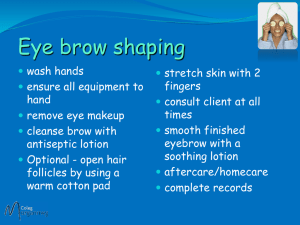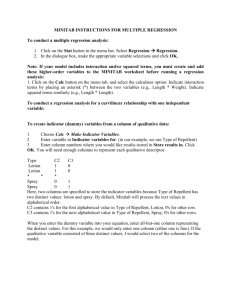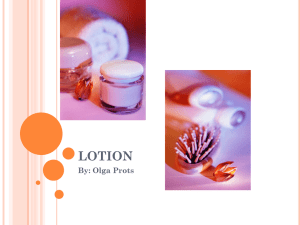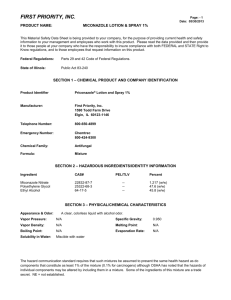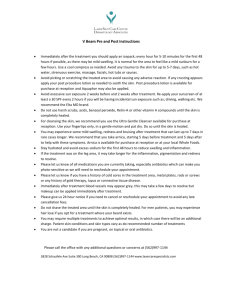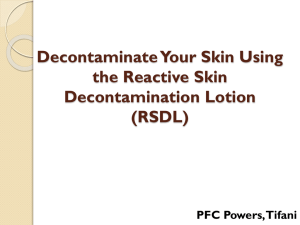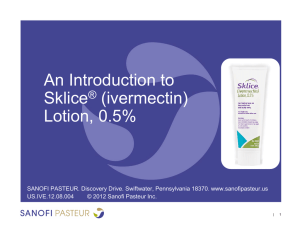SKIN CARE BEAUTY LAB - lavanya-healthcare
advertisement
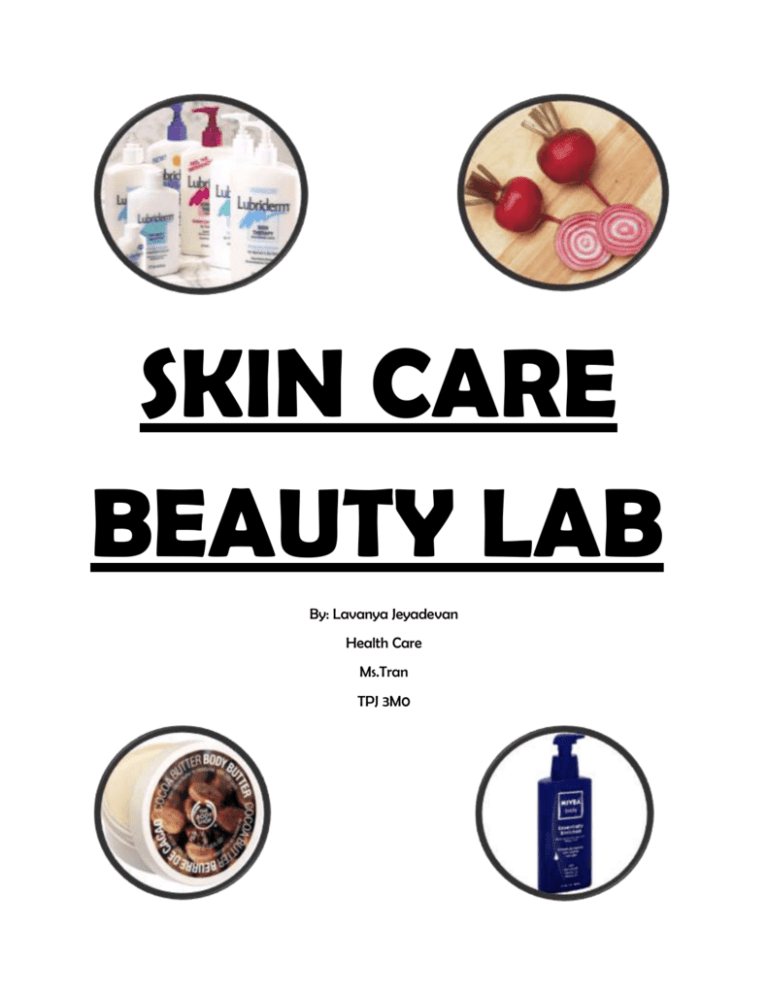
SKIN CARE BEAUTY LAB By: Lavanya Jeyadevan Health Care Ms.Tran TPJ 3M0 INTRODUCTION: The intention of this experiment is to find out what lotion of the three we choose will take the longest to dry up when applied to vegetable skin and is heated. PURPOSE: To find out which lotion will stay for the longest. HYPOTHESIS: If I did an experiment to see which lotion will take the longest to dry on vegetable skin, then it would be the Lubriderm lotion. MATERIALS: 2 glass dishes Timer 3 different types of lotion Hot plate Paint brush Stereomicroscope Microscope slide Scissors A cup of water Paper towel A pair of forceps A pair of tweezers PROCEDURE: 1. Cut as many of the skin specimens you need for this experiment, make sure they have same dimensions 2. Put them in the cup containing water to keep them from drying out, except for 1 piece (call it piece A) 3. Observe that piece A under the microscope, record and label your observation 4. Put the piece A aside on a glass dish 5. Take another piece of your specimen from the cup (call it piece B) 6. Carefully dab it on paper towel to soak away the water, try not to damage it physically 7. Use the paint brush to thinly spread on the lotion on both sides of piece B 8. Place piece B on a glass dish, note the lotion used 9. Put both glass dish on the hot plate, immediately start the timer 10. Crank the dial to maximum. Be careful with handling hot plate! 11. When piece A looks “dry”, note & pause the time, turn the hot plate off 12. Remove both glass dish off the hot late using the forceps 13. Gently wipe off the lotion on piece B using a paper towel 14. Observe piece B and piece A under the microscope, record & label your observations 15. If piece B does not look as dry as piece A, reapply the lotion on piece B and reheat only piece B 16. Repeat steps 12-15 every 3 minutes until piece B is as dry as piece A (course only for piece B NOT piece A) 17. Note the time length 18. Take out two other pieces of skin specimen from the cup, carefully dry them 19. Repeat steps 4-17 for the other two lotions OBSERVATIONS: 3) INNER SKIN OUTER SKIN 1 3 LUBRIDERM LOTION: - PieceB with Lubriderm lotion dried in 3 minutes and 7 seconds PieceA (no lotion) Inner skin Outer skin - Cracks - Burnt - Burnt - Less sparkly - Reddish - Black spots PieceB (with lotion) Inner skin Outer skin - Cracks - Cracks - Not sparkly COCOA BODY BUTTER: - PieceB with Body Butter lotion dried in 12 minutes and 15 seconds - PieceB was reheated an addition of two times PieceA (no lotion) Inner skin Outer skin - Cracks - Burnt - Burnt - Less sparkly - Reddish - Black spots PieceB (with lotion) - Looks wet - Not dry - No cracks NIVEA LOTION: - PieceB with Nivea lotion dried in 6 minutes and 39 seconds - PieceB was reheated one more time. PieceA (no lotion) Inner skin Outer skin - Cracks - Burnt - Burnt - Less sparkly - Reddish - Black spots RESULTS: After observing all three lotions, I found that Body Butter is the best lotion compared to Nivea and Lubriderm. It took the longest to dry up so that shows that if it is applied to the human body, it will stay on the skin for long. CONCLUSION: So overall the purpose of this experiment was to choose three lotions and figure out by experimenting on fruit or vegetable skin to see which one will last the longest. At the beginning, I took a guess and predicted that Lubriderm would last the longest. In the end, my hypothesis was wrong because after all the testing, I found out that cocoa body butter is the long lasting lotion when compared to Nivea and Lubriderm. The Lubriderm lotion ended up taking the least amount of time to dry. DISCUSSION: 1. Of the three lotions that you have tested, which one is the best moisturizer of your skin specimen? Explain why. After testing three different types of lotion, cocoa body butter, Lubriderm and Nivea, we came to a conclusion that Cocoa body butter is the best moisturizer. We came up with this assumption because Cocoa body butter took the longest to dry when applied on beet and heated. The lotion took 14 minutes and 15 seconds while Lubriderm took 3 minutes and 7 seconds and Nivea took 6 minutes and 39 seconds. 2. How is the pricing for the different lotions? Compare the cost and value of these lotions. The pricing for the lotions do not differ as much. The pricing of the lotion was different by a dollar or two but the most expensive lotion was cocoa body butter and it was the one that lasted the longest when experimenting all of the lotions. Lubriderm was the least expensive and was the one that took the least amount of time to dry. So when comparing the cost for the lotion and the quality, the more expensive the better. This may not be the case at all times but for my experiment, that is what was shown. 3. What are the ingredients in these lotions? Are there any differences in the ingredient list? - If yes, explain how this might have affected the result (do research on the functions of the ingredients) - If no, explain what might have caused the different moisturizing effect on the skin specimen The ingredients in all three lotions vary. The ingredients for the cocoa body butter is Aqua (Water) (Solvent/Diluent), Glycine soja (Soybean Oil) (Emollient/Skin Conditioner), Theobroma cacao (Cocoa Butter) (Emollient), Butyrospermum parkii (Shea Butter) (Emollient), Glycerin (Humectant), Cyclomethicone (Emollient), Glyceryl Stearate (Emuls) The ingredients for Lubriderm are Water, Butylene Glycol, Mineral Oil, Petrolatum, Glycerin, Cetyl Alcohol, Propylene Glycol Dicaprylate/Dicaprate, PEG-40 Stearate, C11-13 Isoparaffin, Glyceryl Stearate, Tri (PPG-3 Myristyl Ether) Citrate, Emulsifying Wax, Dimethicone, DMDM Hydantoin, Methylparaben, Carbomer, Ethylparaben, Propylparaben, Titanium Dioxide, Disodium EDTA, Sodium Hydroxide, Butylparaben, and Xanthan Gum. The ingredients for Nivea are Parafinnum liquidum, PEG-150, methylparaben, butylparaben, ethylparaben, isobutylparaben, propylparaben, simethicone, BHT, parfum, limonene, geraniol, linalool, hydroxycitronellal, hydroxyisohexyl 3-cyclohexane carboxaldehyde, citronellol. The more different the chemicals are, the more difference the lotion may have. 4. What are the “controls” in the experiment and why do you need them? For this experiment, I found the controls to be the temperature and the amount of lotion. If the same amount of lotion is not applied to the vegetable skin, the results may differ because of that. The same goes with the temperature level the vegetable skin is getting heated up with. The results might change if the temperature is different for the lotions. For example, if there is more heat for one particular lotion, most likely it will dry up faster compared to a lotion that had less heat given to it. 5. Discuss any experimental errors that might be existed with your procedures. Some experimental errors that took place during the experiment were 6. Can you trust this results using fruit/vegetable skin to be applied on human skin? Explain your reasons. We cannot trust the fruit/vegetable skin results to be applied to human skin because the structure of the human skin and fruit/vegetable skin is different. We cannot trust the results but we can use the results to get an idea of how a particular lotion will affect the human skin. 7. Explain how you can improve the procedure to get results that are applicable to human skin care? REFERENCE: http://www.theecologist.org/green_green_living/behind_the_label/269124/behind_the_label_n ivea_moisturising_lotion.html http://www.lubriderm.com/page.jhtml?id=/lubriderm/products/prd_sst_lotion.inc http://www.thebodyshop-usa.com/body-butter/prod160183
